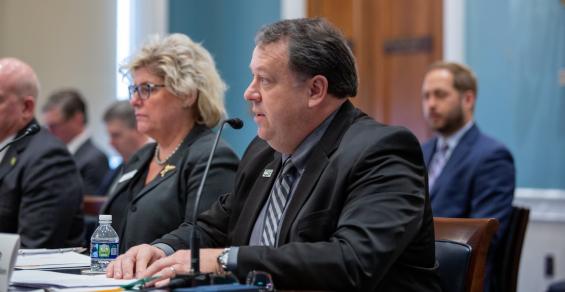Farm bill hearings call for look at permanent disaster program and updating reference prices.
Oversight of the 2018 Farm Bill continued March 1 as the House Agriculture Committee held its third hearing in recent weeks on potential needed changes to farm policy. The full committee heard from a full array of nine commodity groups who consistently shared the challenge of higher input costs weighing on farmers and the need to continue a strong farm safety net.
With the expiration nearly two years away, much of the work by commodity groups’ grassroots policy efforts are underway now. The upcoming Commodity Classic annual meeting of the corn, soybean, wheat and sorghum growers will present a key point for discussion on where changes may be warranted.
During his testimony, American Soybean Association President Brad Doyle, a soybean farmer from Arkansas, reflected on farmer feedback received from ASA’s 12 farm bill listening sessions, farm bill survey, and written comments received, highlighting two primary concerns of U.S. soybean growers regarding the Average Revenue Coverage and Price Loss Coverage: soybeans have an insufficient reference price and a low level of base acres.
Other commodity groups, including rice, cotton and peanut, discussed the challenges with the current reference prices as breakeven prices increase. Doyle shares that the current reference price for soybeans is $8.40, however, Purdue University estimates the current breakeven price for soybeans is $11.07.
As Congress looks to address possibly increasing reference prices, Doyle says soybean growers don’t want the set reference price to drive or change decisions from year, but rather for producers to use it as a tool in still capturing what the market needs based on supply and demand.
Chris Edgington, Iowa farmer and president of the National Corn Growers Association, says the grassroots efforts at NCGA are just beginning to build on surveys and known regional differences among corn producers.
He says where to set references prices will be an area under further study. “If we had a stable market every year it would be an easier discussion than the volatility we live in,” he says. “It’s a very challenging discussion and definitely taking time to analyze where we should be at.”
National Association of Wheat Growers Vice President Nicole Berg, a Paterson, Washington farmer, notes how ARC and PLC don’t adequately cover the cost of production. Additionally, she acknowledged supply chain issues facing farmers, as well as the cost and availability of inputs that are negatively impacting wheat producers. She shared that glyphosate used to be $15/acre and is now $82.
Permanent disaster under consideration
The 2018 Farm Bill included the Wildfire and Hurricane Indemnity Program Plus to offer disaster assistance following natural disasters. However, commodity group representatives shared that the payments are often delayed as much as two years following the disaster event. Yet, the ad hoc assistance versus stable safety net programs such as ARC, PLC and crop insurance question the need for the additional level of support for disaster aid on top of traditional farm bill support.
Edgington says corn producers have historically been in the ad hoc supporters’ camp and have faced severe blows such as with the derecho in 2020. “Mother Nature is still our biggest wild card. To write a program that is permanent based on what Mother Nature is going to do is a challenge because we don’t know what it will do,” Edgington says.
Doyle, meanwhile, says soybean producers rely heavily on crop insurance as 90% of soybean growers participate. ARC and PLC have been less used in recent years. “I think we’re open to some sort of protection when a disaster comes up,” he says.
Robert Johansson, director of economics and policy analysis at the American Sugar Alliance and former USDA chief economist, says a standing disaster program would need to be consistent with crop insurance and also encourage additional coverage.
Rep. Sanford Bishop, D-Ga., who also serves as agricultural appropriations chair, urged commodity groups to further explore what is desired out of a permanent disaster program and “help forge solutions to these problems” and “help us so we can craft in the new farm bill some policy solutions that will address these concerns.”
Crop insurance still priority No. 1
Crop insurance continues to be called the top priority for agricultural producers and a “vital piece” of the farm safety net, according to Edgington.
Doyle says Congress gives farmers tools in the farm bill to be less risky, and new and beginning farmers can provide assurances to bankers as the government helps balance that risk.
Clark Coleman, a specialty crop grower from North Dakota, adds the stability and certainty of the farm safety net that the Title 1 and crop insurance programs represent will remain the “top priority and driving force in the timely reauthorization of a bipartisan farm bill in 2023.”





